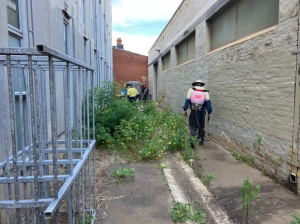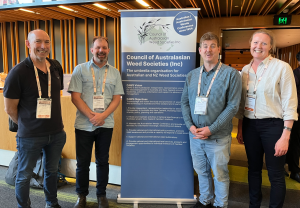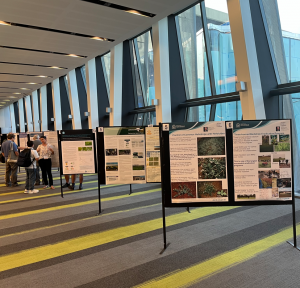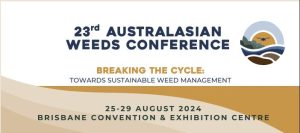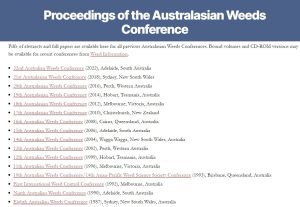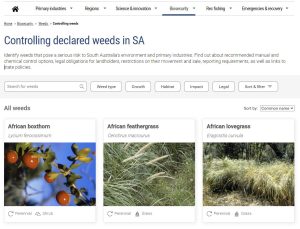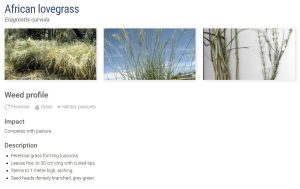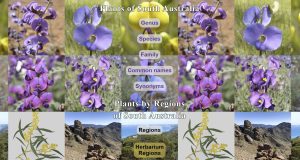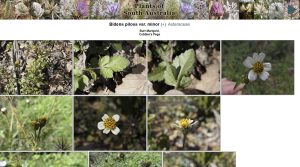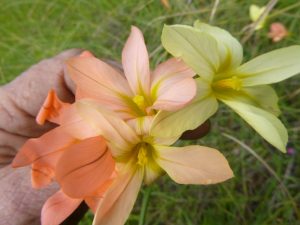[speedy] AGM. Followed by [weedy] entertainment. All welcome! Guest speaker, weedy wine tasting, live music, plant and weed identification, food and drink, conversation and more…
G’day weedos. The Weed Management Society of South Australia (WMSSA) are hosting the 2024 AGM, with a special guest speaker David Cooke, and our very own Chris Brodie and Shannon Robertson. We aim to bring together those interested in weeds, native plants, and natural history. Please come along for an informative and fun evening, and be sure to share your stories with the WMSSA group. Every story is worth telling…
What: Guest speakers will present a series of thought provoking talks about native and weedy plant, there will be; weedy wine tasting, live music (not too loud), weed identification, plant discussion, nibbles, drinks, and fun till late. Bring a weed for identification or a weed story if you like.
When: Wednesday 27 November, 5-9 PM.
Where: Adelaide Botanic Gardens, Goodman Lecture theatre, Hackney Road, (opposite the old Tram Barn, 150 m north of the Wine Centre along Hackney Road).
Who: You! Members and non members welcome. These events welcome anyone with an interest in weeds and natives plants.
What to bring: Compulsory: You. Optional: Interesting or unknown weeds or native plants for identification and discussion; and a plate or bottle to share..
Our speaker: David Cooke: David’s long and distinguished career started at the Melbourne Sate Herbarium where he worked as an expert witness identifying Cannabis species in legal proceeding. David moved to south Australia for a role in the Animal and Plant Control commission. He became involved in weed policy issues and weed risk assessment, quickly gaining a reputation as an authoritative, go-to, and well regarded authority in the weeds community. Now an leading light and authority in Iridaceae taxonomy in Australia, David’s unique perspectives in the world of weeds is sure to delight any one with an interest in plants.
G’day weedos
WMSSA are proud to announce that we will be hosting a two (2) day State weed and pest Animals Conference in Adelaide in September 24-25, 2025, at the University of Adelaide, North Terrace Campus.
This is a great opportunity for weed and pest animal practitioners, enthusiasts, and community groups to come together to share information, experiences and learnings. We want to hear about what you are doing. Every story is worth sharing.
More details to come. Check out our events page for the latest information on the ‘South Australian Weeds and Vertebrate Pests Conference’. Watch this space for further details.
It’s gonna be great.
G’day weedos,
A cohort of Weed Management Society of South Australia (WMSSA) members enjoyed the 23rd AWC with many great presentations as well as the all important networking at the main conference dinner MC’ed by Pip Courtney of ABCs Landline.
See some of the highlights from Brisbane at the Australasian Weeds Conference Facebook page.
The next conference Australasian Weeds Conference will be held in Christchurch, New Zealand, 23-27 August 2026. We hope to see you there… Its gonna be a banger!
The 23rd Australasian Weeds Conference, Brisbane, August 2024. What an event!
G’day Weedos. What an amazing 3 days of informative presentations including talks, poster sessions, breakout sessions, and all informal catchup up over tea, coffee and lunch, and conference dinner. These events and catchups with weedos from around Australia and New Zealand all contributed to an epically successful 23rd Australasian Weeds Conference on August 25 to 29, 2024, at the Brisbane Convention and Exhibition Centre.
The E-proceedings including all abstracts and full papers from across the entire conference is now available here. The conference program is available here.
From the WMSSA, thank you to Queensland Conference Organizing Committee and to all the participants that made this a great event.
Are weeds bad?
Are weeds good?
The 22nd Australasian Weeds Conference was held on 25-29 September 2022, Adelaide, SA. The proceedings of this conference are available here.
The next conference will be in Brisbane on 25-28 August 2024.
For all other conference proceedings from 1954 onwards please visit the CAWS – Council of Australasian Weed Societies, publications website.
There are so many weeds and so many different ways to control weeds. What method do I use for my weeds in my patch?
The PIRSA website lists all weeds that are declared. Included are control methods for trees, shrubs, herbs, cacti & succulents, climbers, grasses, bulbs and aquatic weeds. Weeds are listed by either common name, scientific name, weed type, growth type, habitat, impacts, the legal requirements and significance.
Each page for the over 140 species includes photos, weed profile, impacts, descriptions, and the all important control options.
Check out the PIRSA Controlling declared weeds in SA website (link here)
There are over 5170 naturally occurring vascular plant taxa recognised in South Australia. Of these over 1710 are alien plants that are considered to have become established to some degree in the wild. In other words, about one third of South Australia’s plant taxa are weeds.
How do I get to know what all these weeds and native plants look like you may ask? At the touch of a button via your PC or device you can access a wealth of information from the Plants of South Australia website.
This pictorial website showcases a wealth of images, distribution maps, ecological information, and seed germination details for many species. You can search for a plant species by genus, species, family, common names, synonyms, or by region.
The useful help page (link here) informs the user on the various filters available to help navigate this comprehensive and informative site.
If you want to learn more about the plants in your patch why not use plants of South Australia.
A paper by Michael Ansong and Catherine Pickering details a global review of literature on the subject of weeds that can germinate from horse dung. ( Ansong, M. and Pickering, C. (2013), A global review of weeds that can germinate from horse dung. Ecological Management and Restoration, 14:216-223)
“Seed from 249 species from 43 families have been identified germinating from horse dung. Almost two-thirds of the species were forbs and 33% graminoids (grasses), with over half being perennials and 32% annuals. Nearly every species (totalling 99% of those reviewed) is considered a weed somewhere, with 47% recorded as invasive and 19% as international weeds.” The appendix to Ansong and Pickering’s paper details these 249 species.
“Of the 2739 non-native plants that are naturalised in Australia, 156 have been shown to germinate from horse dung. This includes 16 of the 479 listed noxious weeds in Australia and two weeds of national significance. Seed traits including seed size, length, width and mass affect seed dispersal via horse dung. Habitat disturbance from trampling facilitates germination of seedlings. The diversity of species with seed that can germinate from horse dung highlights the potential of horses to disperse a range of seed over long distances”
”Several studies have found large amounts of viable seed in horse dung, with estimates of … 500,000 viable seeds produced per horse per year. Horse riding can spread seed on fur, hooves, riders, equipment and feed as well as in dung.”
This study highlights the potential for weed-spread into environmental protected areas, especially where trails skirt the edge or pass through such areas, for example the Mylor Conservation Park.
Horse SA has produced a range of publications regarding hygiene with respect to weed seeds and also Phytophthora, the plant-pathogenic, subterranean fungus, or more correctly, a water mould.
For the bushcare worker or property owner with bushland, many of the weeds spread by horses pose various levels of threat and inconvenience often taking valuable time away from dealing with the many other weeds that bushland is subject to. The 249 weed species mentioned above contains many grasses ( Poaceae family ), medics ( Medicago sp.), clovers ( Trifolium sp.) and rushes ( Juncus sp. ). Others of local interest include:-
– bedstraws ( Gallium sp. );
– blackberry nightshade ( Solanum nigrum );
– common chickweed ( Stellaria media );
– common plantain ( Plantago lanceolatum );
– daisies such as smooth cat’s ear ( Hypochaeris glabra ) and dandelion ( Taraxacum officinale );
– docks ( Rumex sp. );
– fat hen ( Chenopodium album );
– horehound ( Marrubium vulgare );
– shepherds purse ( Capsella bursa-pastoris );
– St John’s wort ( Hypericum perforatum );
– wild onion ( Asphodelus fistulosis ).
– wireweed ( Polygonum aviculare ).
Note that wild onion is not the white-flowered 3-cornered garlic (Allium triquetrum). Both Asphodelus and Allium are, confusingly, called ‘onion weed’ in various parts of the Adelaide Hills.
In Southern Australia, there are a number weeds that are toxic to horses. Many of these weed species can occur in pastures. Some species have to be eaten in large quantities to have a noticeably deleterious effect. This occurs when toxic weed species dominate a pasture. These toxic weed species may be regarded as food or medicine when consumed in small quantiles in a mixed pasture.
Alternatively, some weed species can have serious effects in small quantities, e.g. the Cape tulips, one-leaf Cape tulip (Moraea flaccida) and the less common two-leaf Cape tulip (Moraea miniata). These are of African origin. Note that the genus Moraea has been changed from Homeria.
There is an online resource produced by Rural Industries Research and Development Corporation (RIRDC) entitled “Plants Poisonous to Horses – An Australian Field Guide”. Plants are listed by common names under the headings of the conditions caused by their toxic chemistry; a good overview of equine symptoms. Similar symptoms can be caused by various species, amounts and interactions of toxic chemistry. The list can be very helpful if you note the diet of your horse in places of forage, and consider toxic profiles of plants and interactions consumed. Seasonal or weather conditions, pH of the soil and other salient factors modify symptoms. It would be even more useful if the Field Guide could also be accessed from alphabetic lists of common and scientific names of the plants.
Food eaten by horses passes straight through the digestive system which results in many weed seeds surviving to be neatly deposited in nutrient-rich dung. By contrast, ruminants such as cattle re-digest the gut contents more than once which results in the destruction of much or all of the weed seed load. This has lead to the call for horse riders to collect the dung of their mounts when riding through environmentally sensitive areas, similar to dog owners. This practice would reduce the financial and environmental impost caused by weeds.


